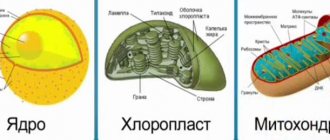Test with answers: “Type Criteria”
1. A great contribution to population genetics was made by the following scientists: a) Chetverikov + b) Severtsev c) Roulier
2. A set of individuals that are similar in structure, have a common origin, freely interbreed with each other and produce fertile offspring is called: a) class b) species + c) population
3. For species living in Baikal, the range is limited to this lake, this is an example of ... criteria: a) morphological b) ecological c) geographical +
4. Source of reserve of hereditary variability of populations: a) mutation processes + b) isolation c) migration
5. Features of the external structure of the common mole, example of a criterion: a) ecological b) geographical c) morphological +
6. An elementary evolutionary unit is: a) species b) population + c) individual
7. Under natural conditions, populations do not mix with each other. This is prevented by: a) geographical barriers b) morphological differences c) all answers are correct +
8. Species criterion, which is based on the similarity of the external and internal structure of an individual of the same species: a) morphological + b) ecological c) geographical
9. The main criteria of a species are: a) geographical + b) physiological c) morphological +
10. The criteria for a species, which includes a set of environmental factors that make up the immediate habitat of the species, is ... criterion: a) morphological b) ecological + c) geographical
11. Which of the statements illustrates the ecological criterion of a species: a) both animals feed on the same plants + b) both animals live in the same territory c) these animals have the same set of organs
12. The set of environmental factors in which a species lives is a species criterion: a) physiological b) ecological + c) morphological
13. To determine a species, it is not enough to use only a morphological criterion, since: a) there are twin species + b) species are divided into populations c) species interbreed
14. In what case can two hares be classified as different species: a) if they live in different territories b) if one group is less fertile than the other c) if they have a different number of chromosomes in their cells +
15. Which species criterion refers to the presence of 46 chromosomes in a person: a) genetic + b) biochemical c) physiological
16. Scientists consider the brown bear and the spectacled bear to be different species because: a) they live in different territories b) there is reproductive isolation between them + c) they differ in appearance
17. The genetic criterion of a species is characterized by: a) external characteristics b) similarity of biochemical composition c) set of chromosomes +
18. The arboreal lifestyle of the common tree frog meets the species criteria: a) genetic b) ecological + c) morphological
19. What characteristic illustrates the physiological criterion of the type of shepherd’s purse: a) distribution over fields, roads, weedy places b) alternate arrangement of leaves on the stem c) metabolic features in the plant +
20. The white hare and the brown hare belong to: a) the same species b) different species + c) the same population
21. When recognizing sibling species, the following criteria are taken into account: a) genetic + b) physiological c) morphological
22. The relativity of the ecological criterion of a species is that: a) the sets of chromosomes in different species are the same b) different species live in similar conditions + c) the ranges of different species are the same
23. The physiological criterion of a species is manifested in all its individuals in the similarity of: a) chemical composition b) structure and shape of chromosomes c) vital processes +
24. Which of the following characteristics can be attributed to the ecological criterion of the species of the common hedgehog: a) presence of spines on the body b) terrestrial lifestyle + c) distribution in Europe
25. The habitat of animals is a criterion of the species: a) biochemical b) morphological c) ecological +
26. The ability of black henbane to synthesize and accumulate alkaloids is an indicator of the type of criterion: a) morphological b) biochemical + c) genetic
27. A species is a group of individuals: a) interbreeding and producing fertile offspring + b) belonging to the same variety or breed c) living in the same natural community
28. Species - a set of individuals: a) created by man on the basis of selection b) having the ability to form food connections between its individuals c) having a similar set of chromosomes +
29. Characteristic features and properties by which some species differ from others: a) criteria + b) methods c) capabilities
30. One of the main criteria: a) biophysical b) biochemical + c) biogenic
Unified State Exam Test Biology Grade 11 Free View. Criteria and structure. Speciation. Populations
An example of allopatric speciation is the great and Japanese tits; they once had a common ancestor and the same habitat.
Then a geographical barrier arose between the populations (glacier, ravine, etc.)
And in isolated territories, already in different conditions of existence, due to natural selection, new subspecies, and then new species, arose in the population.
Subsequently, geographic isolation disappeared and a contact zone formed.
But during isolation, many genetic differences arose in these separated populations of birds, which led to the inability of individuals from separated populations to interbreed, which later became the reason for the formation of new species - the great tit and the Japanese tit.
Related species of lily of the valley arose in the same way.
The common ancestor of the lily of the valley several million years ago (in the Tertiary period) was widespread in the deciduous forests of Eurasia.
With the onset of glaciers in the Quaternary period, the single habitat of the species was torn into several parts, and the lily of the valley survived only in areas that escaped glaciation (the Far East, Transcaucasia, Southern Europe).
After the retreat of the glacier, lily of the valley, which remained in southern Europe, again spread through deciduous and partially mixed forests, forming a new species, larger, with a wide corolla.
In the Far East, separated from Europe by vast expanses of taiga, another species arose - with red petioles and a waxy coating on the leaves.
Also, the existence of endemic species is the result of long-term geographic isolation.
For example, Lake Baikal has been isolated from other bodies of water for 20 million years, so it is characterized by representatives of living organisms that are not found anywhere else - these are the Baikal seal, the golomyanka fish, the Baikal omul and others.
For the emergence of endemics, a special role belongs to island isolation, thanks to which such animal species appeared and formed: hatteria (islands off New Zealand), 13 species of Galapagos or Darwin's finches, representatives of the fauna of the island. Madagascar (tenrecs, lemurs), New Zealand (kiwi), Australia (various types of marsupials, parrots).
Formation of the species of large gulls - herring gulls and laughing black gulls
Along the coasts of the Baltic and North Seas, two species of large gulls live without interbreeding - the herring gull and the laughing black gull.
These two species are associated with each other through an unbroken chain of subspecies, covering northern Eurasia on the one hand, and Greenland and North America on the other.
Several hundred thousand years ago, the ancestral form of these gulls lived in the area of the modern Bering Strait.
Differences gradually accumulated in individual populations (features of lifestyle, some morphological features, etc.), these differences turned out to be sufficient for the emergence of two new species, very similar to each other.
If for some reason the continuous chain of subspecies is broken somewhere, then two different species will arise.
Now speciation in this group of gulls is, as it were, “in the process of formation.”
A similar example of a chain of subspecies, the outermost links of which may be called species, is described for the grouse and the ptarmigan.
Most species, especially animals, arise through the allopatric method of speciation!
Biology lesson for 11th grade View. Type criteria
IY. Updating knowledge.Next we’ll tell fortunes using the “Star Daisy” (the sentences are written on the flower petals)
Species
is the basic taxonomic category of biological classification.
The first idea of a species was created by Aristotle, who defined a species as a collection of similar individuals.
The term “species” itself is translated from Latin as “image”. The concept of “species”
was first introduced at the end of the 17th century. English botanist John Ray (1627-1709), who noted that different species differ in external and internal structure and do not interbreed.
A major contribution to the further development of the concept of “species” was made by the Swedish scientist Carl Linnaeus (1707–1778). According to his ideas, species are formations that objectively exist in nature, and there are differences to a greater or lesser extent between different species. So, for example, a bear and a wolf clearly differ from each other in external characteristics, while a wolf, a jackal, a hyena, and a fox are more similar in appearance, since they belong to the same family - wolves. The appearance of species of the same genus is even more similar. That is why the species began to be considered as the main classification unit. This was of great importance for the development of systematics. Thus, the beginning of the description and classification of living organisms is associated with the name of Linnaeus. This work continues to this day.
A biological species is not only the basic taxonomic unit in biological systematics. This is an integral structure of living nature, which is reproductively isolated from other similar structures and has its own destiny. The integrity of this system is given, firstly, by the processes of interaction between individual individuals. The relationships between organisms of different generations, between parents and children, males and females, features of territorial behavior - all this determines the internal structure of the species! Species characteristics do not always ensure the survival of an individual, but they are always favorable for the species as a whole. For example, a bee that has lost its sting will die, but at the same time it will protect the rest of the individuals, a female spider eats the male after mating, this is bad for the individual and good for the species, since
Group assignment
Group 1 Bison and bison are two species belonging to the same genus. They are very similar in appearance and in captivity produce fertile bison offspring. In nature they do not interbreed, since they live on different continents - the bison in Europe, and the bison in North America. How can we call this type criterion?
2nd group . It has been established that under the name “black rat” there are two species hidden - a double: rats with 38 and 42 chromosomes. They do not interbreed with each other. How can we call such a criterion?
Task No. 2 There is a clear division of ecological niches between closely related species. For example, some species of robins in coniferous forests, at first glance, occupy one niche, but some of them feed on the outer and others on the inner branches of trees. What criterion is fundamental in this case?
Group 3. Determine the systematic position of the depicted plants. Describe each plant according to morphological criteria.
Problem No. 2 : Chimpanzee hemoglobin is no different in amino acid sequence from human hemoglobin, but gorilla has two differences in amino acid sequence. What criteria are we talking about?
Group 4 1. At the very beginning of the 19th century, a dilemma arose in biology in its views on the problem of species, which can be expressed in one phrase: “Either species without evolution, or evolution without species.” Explain the meaning of this expression; with the works of which scientists are such views on the problem of species associated?
Problem No. 7. In two lakes that do not communicate with each other, different types of fish live: crucian carp, roach, ide, bream, pike perch.
A) how many fish populations live in the second lake?
B) how many fish populations live in the first lake?
C) how many species of fish live in the two lakes?
D) How many fish populations live in the two lakes?
- What is a species? Name the types of plants, animals and fungi known to you that are found in your area.
- Which criterion, in your opinion, is the most visual and understandable? What other criteria are there? Describe them.
- Two cultivated plants - barley and rye have the same number of chromosomes (14), but do not cross; have differences in external structure; their seeds differ in chemical composition (bread is not usually baked from barley flour). Based on what criteria will you prove that these plants belong to different species?
- Based on what knowledge can ecological and geographical criteria be established?



